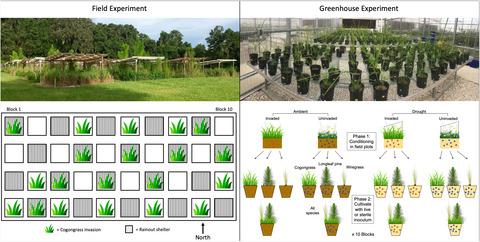Our official English website, www.x-mol.net, welcomes your feedback! (Note: you will need to create a separate account there.)
Soil microbes alter competition between native and invasive plants
Journal of Ecology ( IF 5.5 ) Pub Date : 2021-10-31 , DOI: 10.1111/1365-2745.13807 C. Fahey 1, 2 , S.L. Flory 3
中文翻译:

土壤微生物改变本地植物和入侵植物之间的竞争
更新日期:2021-10-31
Journal of Ecology ( IF 5.5 ) Pub Date : 2021-10-31 , DOI: 10.1111/1365-2745.13807 C. Fahey 1, 2 , S.L. Flory 3
Affiliation

|
- Invasive plants can alter soil microbial communities and generate positive plant–soil feedbacks that facilitate their performance, but the magnitude and direction of feedbacks may change with novel conditions under climate change. We assessed how potential soil legacy effects of plant invasion and simulated drought influenced plant performance and competition in the longleaf pine ecosystem.
- We collected soil from a 4-year factorial invasion (cogongrass Imperata cylindrica) by drought (simulated with rainout shelters) field experiment and used it as live or sterilized soil inoculum in a greenhouse experiment that included two native foundation species, longleaf pine Pinus palustris and wiregrass Aristida stricta, and cogongrass, grown individually or in competition.
- There was no evidence of biotic soil legacy effects of invasion or drought for any plant species, but microbes played a significant role in competition. When plants were grown alone, the invader had 12% greater biomass in live soil than sterile soil but both native species had 25% less biomass in live soil. When grown in competition, these effects were reversed for cogongrass (37% smaller in live soil) and pine (17% larger in live soil). In competition, the three species grown in sterile soil produced similar amounts of biomass, whereas live soil created a competitive hierarchy where pine was more competitive than wiregrass and cogongrass.
- Synthesis. These results emphasize the importance of soil biota in native plant restoration because, although the invader was highly successful when grown alone, plant–microbe interactions influenced the outcome of competition between native and invasive species by promoting native longleaf pine. There was little evidence that invasive cogongrass inhibited native plants via biotic soil legacies, instead, results suggested that plant–soil interactions can be highly resilient to global change such that the biotic legacy of invasion and drought may not promote or inhibit invasion.
中文翻译:

土壤微生物改变本地植物和入侵植物之间的竞争
- 入侵植物可以改变土壤微生物群落并产生积极的植物-土壤反馈,促进它们的表现,但反馈的幅度和方向可能会随着气候变化下的新条件而改变。我们评估了植物入侵和模拟干旱的潜在土壤遗留效应如何影响长叶松生态系统中的植物性能和竞争。
- 我们通过干旱(用避雨棚模拟)田间试验从为期 4 年的因子入侵(白茅白茅)中收集土壤,并将其用作温室试验中的活的或灭菌的土壤接种物,其中包括两种本地基础物种,长叶松Pinus palustris和wiregrass Aristida stricta和白茅,单独或在竞争中生长。
- 没有证据表明入侵或干旱对任何植物物种的生物土壤遗留影响,但微生物在竞争中发挥了重要作用。当植物单独生长时,入侵者在活土壤中的生物量比不育土壤高 12%,但两种本地物种在活土壤中的生物量都少 25%。当在竞争中生长时,这些影响在康草(活土中小 37%)和松树(活土中大 17%)中发生了逆转。在竞争中,在不育土壤中生长的三种物种产生了相似数量的生物量,而活土壤创造了一个竞争等级,松树比铁丝草和白茅草更具竞争力。
- 合成。这些结果强调了土壤生物群在本地植物恢复中的重要性,因为尽管入侵者在单独生长时非常成功,但植物-微生物相互作用通过促进本地长叶松影响本地和入侵物种之间的竞争结果。几乎没有证据表明入侵的白茅通过生物土壤遗产抑制本地植物,相反,结果表明植物 - 土壤相互作用可以高度适应全球变化,因此入侵和干旱的生物遗产可能不会促进或抑制入侵。



























 京公网安备 11010802027423号
京公网安备 11010802027423号